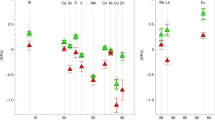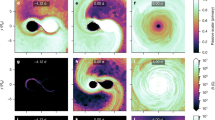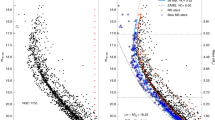Abstract
Although the proximity of the Andromeda galaxy (M31) offers an opportunity to understand how mergers affect galaxies1, uncertainty remains about M31’s most important mergers. Previous studies focused individually on the giant stellar stream2 or the impact of M32 on M31’s disk3,4, thereby suggesting many substantial satellite interactions5. Yet models of M31’s disk heating6 and the similarity between the stellar populations of different tidal substructures in M31’s outskirts7 both suggested a single large merger. M31’s stellar halo (its outer low-surface-brightness regions) is built up from the tidal debris of satellites5 and provides information about its important mergers8. Here we use cosmological models of galaxy formation9,10 to show that M31’s massive11 and metal-rich12 stellar halo, containing intermediate-age stars7, dramatically narrows the range of allowed interactions, requiring a single dominant merger with a large galaxy (with stellar mass about 2.5 × 1010 solar masses, M☉ the third largest member of the Local Group) about 2 billion years (Gyr) ago. This single event explains many observations that were previously considered separately: M31’s compact and metal-rich satellite M3213 is likely to be the stripped core of the disrupted galaxy, its rotating inner stellar halo14 contains most of the merger debris, and the giant stellar stream15 is likely to have been thrown out during the merger. This interaction may explain M31’s global burst of star formation about 2 Gyr ago16 in which approximately a fifth of its stars were formed. Moreover, M31’s disk and bulge were already in place, suggesting that mergers of this magnitude need not dramatically affect galaxy structure.
This is a preview of subscription content, access via your institution
Access options
Access Nature and 54 other Nature Portfolio journals
Get Nature+, our best-value online-access subscription
$29.99 / 30 days
cancel any time
Subscribe to this journal
Receive 12 digital issues and online access to articles
$119.00 per year
only $9.92 per issue
Buy this article
- Purchase on Springer Link
- Instant access to full article PDF
Prices may be subject to local taxes which are calculated during checkout




Similar content being viewed by others
References
Sommerville, R. & Dave, R. Physical models of galaxy formation in a cosmological framework. Ann. Rev. Astron. Astrophys. 53, 51–113 (2015).
Fardal, M. et al. Inferring the Andromeda Galaxy’s mass from its giant southern stream with Bayesian simulation sampling. Mon. Not. R. Astron. Soc. 434, 2779–2802 (2013).
Block, D. et al. An almost head-on collision as the origin of two off-centre rings in the Andromeda galaxy. Nature 443, 832–834 (2006).
Dierickx, M., Blecha, L. & Loeb, A. Signatures of the M31-M32 galactic collision. Astrophys. J. 788, 38–44 (2014).
Bullock, J. & Johnston, K. Tracing galaxy formation with stellar halos. I. Methods. Astrophys. J. 635, 931–949 (2005).
Hammer, F. et al. A 2-3 billion year old major merger paradigm for the Andromeda galaxy and its outskirts. Mon. Not. R. Astron. Soc. 475, 2754–2767 (2018).
Bernard, E. et al. The nature and origin of substructure in the outskirts of M31 – II. Detailed star formation histories. Mon. Not. R. Astron. Soc. 446, 2789–2801 (2015).
D’Souza, R. & Bell, E. The masses and metallicities of stellar haloes reflect galactic merger histories. Mon. Not. R. Astron. Soc. 474, 5300–5318 (2018).
Vogelsberger, M. et al. Properties of galaxies reproduced by a hydrodynamic simulation. Nature 509, 177–182 (2014).
Cooper, A. et al. Galactic accretion and the outer structure of galaxies in the CDM model. Mon. Not. R. Astron. Soc. 434, 3348–3367 (2013).
Ibata, R. et al. The large-scale structure of the halo of the Andromeda galaxy. I. Global stellar density, morphology and metallicity properties. Astrophys. J. 780, 128–148 (2014).
Gilbert, K. et al. Global properties of M31’s stellar halo from the SPLASH survey. II. Metallicity profile. Astrophys. J. 796, 76–96 (2014).
Monachesi, A. et al. The star formation history of M32. Astrophys. J. 745, 97–117 (2012).
Ibata, R. et al. On the accretion origin of a vast extended stellar disk around the Andromeda galaxy. Astrophys. J. 634, 287–313 (2005).
Ibata, R. et al. A giant stream of metal-rich stars in the halo of the galaxy M31. Nature 412, 49–52 (2001).
Williams, B. et al. A global star-forming episode in M31 2-4 Gyr ago. Astrophys. J. 806, 48–57 (2015).
van der Marel, R. et al. Improved evidence for a black hole in M32 from HST/FOS spectra. I. Observations. Astrophys. J. 488, 119–135 (1997).
Haring, N. & Rix, H.-W. On the black hole mass-bulge mass. Astrophys. J. 604, 89–92 (2004).
Irwin, M. et al. A minor axis surface brightness profile of M31. Astron. J. 628, 105–108 (2005).
Gilbert, K. et al. Global properties of M31’s stellar halo from the SPLASH survey I. Surface brightness. Astrophys. J. 760, 76–97 (2012).
Bekki, K. et al. A new formation model for M32: a threshed early-type spiral galaxy? Astrophys. J. 557, 39–42 (2001).
Burkert, A. On the formation of compact ellipticals. Mon. Not. R. Astron. Soc. 266, 877–885 (1994).
Choi, P. et al. Tidal interaction of M32 and NGC205 with M31: surface photometry and numerical simulations. Astron. J. 124, 310–331 (2002).
Kormendy, J. in Astrophysics and Space Science Library Vol 418 Galactic Bulges 431–477 (Springer, Berlin, 2016).
Howley, K. Internal stellar kinematics of M32 from the SPLASH survey: dark halo constraints. Astrophys. J. 765, 65–87 (2013).
Read, J. et al. The tidal stripping of satellites. Mon. Not. R. Astron. Soc. 366, 429–437 (2006).
Dalcanton, J. et al. The Panchromatic Hubble Andromeda Treasury VIII. A wide-field, high-resolution map of dust extinction in M31. Astrophys. J. 814, 3–50 (2015).
Olsen, K. et al. The star formation histories of the bulge and disk of M31 from resolved stars in the near-infrared. Astron. J. 132, 271–289 (2006).
Genel, S. et al. Introducing the Illustris project: the evolution of galaxy populations across cosmic time. Mon. Not. R. Astron. Soc. 445, 175–200 (2014).
Vogelsberger, M. et al. Introducing the Illustris Project: simulating the coevolution of dark and visible matter in the Universe. Mon. Not. R. Astron. Soc. 444, 1518–1547 (2014).
Guo, Q. et al. From dwarf spheroidals to cD galaxies: simulating the galaxy population in a ΛCDM cosmology. Mon. Not. R. Astron. Soc. 413, 101–131 (2011).
Penarrubia, J. et al. A timing constraint on the (total) mass of the Large Magellanic Cloud. Mon. Not. R. Astron. Soc. 456, 54–58 (2016).
Tamm, A. et al. Stellar mass map and dark matter distribution in M31. Astron. Astrophys. 546, 4–15 (2013).
Sanchez-Blazquez, P. et al. Stellar population gradients in galaxy disks from the CALIFA survey. Astron. Astrophys. 570, 6–85 (2016).
Amorisco, N. Contributions to the accreted stellar halo: an atlas of stellar deposition. Mon. Not. R. Astron. Soc. 464, 2882–2895 (2017).
Brown, T. et al. The detailed star formation history in the spheroid, outer disk, and tidal stream of the Andromeda galaxy. Astrophys. J. 652, 323–353 (2006).
Fardal, M. et al. Investigating the Andromeda stream – II. Orbital fits and properties of the progenitor. Astrophys. J. 366, 1012–1028 (2006).
Dorman, C. et al. The SPLASH survey: kinematics of Andromeda’s inner spheroid. Astrophys. J. 752, 147–166 (2012).
Gilbert, K. et al. Stellar kinematics in the complicated inner spheroid of M31: discovery of substructure along the southeastern minor axis and its relationship to the giant southern stream. Astrophys. J. 668, 245–267 (2007).
Gilbert, K. et al. Global properties of M31’s stellar halo from the SPLASH survey III: measuring the stellar velocity dispersion profile. Astrophys. J. 852, 128–149 (2017).
Brown, T. et al. The extended star formation history of the Andromeda spheroid at 21 kpc on the minor axis. Astrophys. J. 658, 95–98 (2007).
Brown, T. et al. The extended star formation history of the Andromeda spheroid at 35 kpc on the minor axis. Astrophys. J. Lett. 685, 121 (2008).
Sheth, K. et al. The Spitzer Survey of stellar structures in galaxies. Proc. Astron. Soc. Pacif. 122, 1379–1414 (2010).
Muñoz-Mateos, J. et al. The Spitzer Survey of stellar structure in galaxies (S4G): stellar masses, sizes, and radial profiles for 2352 nearby galaxies. Astrophys. J. Suppl. Ser. 219, 2–31 (2015).
Ferrarese, L. et al. The ACS Virgo Cluster Survey. VI. Isophotal analysis and the structure of early-type galaxies. Astrophys. J. Suppl. Ser. 164, 334–434 (2006).
Rodriguez-Gomez, V. et al. The merger rate of galaxies in the Illustris simulation: a comparison with observations and semi-empirical models. Mon. Not. R. Astron. Soc. 449, 49–64 (2015).
Kirby, E. et al. The universal stellar mass-stellar metallicity relation for dwarf galaxies. Astrophys. J. 779, 102–123 (2013).
Gallazzi, A. et al. The ages and metallicities of galaxies in the local universe. Mon. Not. R. Astron. Soc. 362, 41–58 (2005).
Acknowledgements
We thank J. Dalcanton, A. Cooper, A. Monachesi, S. Trager, M. Valluri, K. Hattori, K. Johnston, P. Guhathakurta, B. Devour, S. Vegetti, J. Runnoe, M. Reiter, P. Mueller, J. Wagner and R. Macke for comments on the draft. We thank A. Cooper for access to his particle-tagging simulations. We thank R. Ibata and K. Gilbert for permission to use their figures in this publication.
Author information
Authors and Affiliations
Contributions
R.D'S. led the project. Both authors contributed equally to writing the Letter. R.D'S. prepared the figures.
Corresponding author
Ethics declarations
Competing interests
The authors declare no competing interests.
Additional information
Publisher’s note: Springer Nature remains neutral with regard to jurisdictional claims in published maps and institutional affiliations.
Supplementary information
Supplementary Information
Supplementary Figures 1−13, Supplementary References 1−33
Rights and permissions
About this article
Cite this article
D’Souza, R., Bell, E.F. The Andromeda galaxy’s most important merger about 2 billion years ago as M32’s likely progenitor. Nat Astron 2, 737–743 (2018). https://doi.org/10.1038/s41550-018-0533-x
Received:
Accepted:
Published:
Issue Date:
DOI: https://doi.org/10.1038/s41550-018-0533-x
This article is cited by
-
Two major accretion epochs in M31 from two distinct populations of globular clusters
Nature (2019)
-
Andromeda’s violent past
Nature Astronomy (2018)



